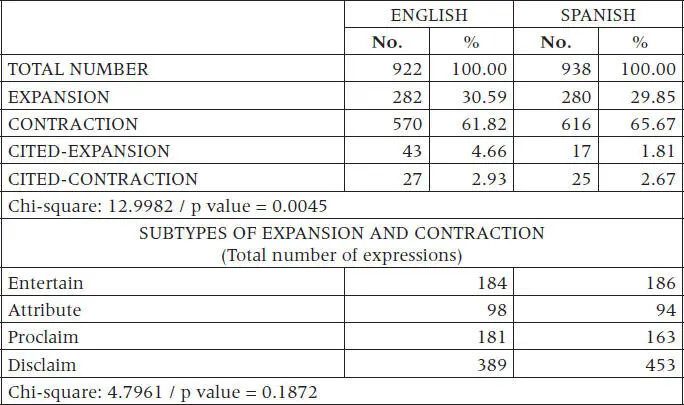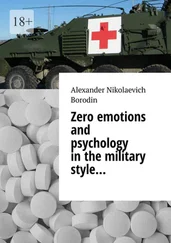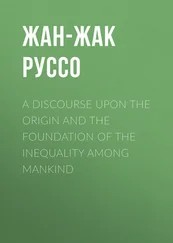Knowledge of the world may also play a role in expressions with the source cited. We know that Marco Polo’s appreciation of geography and raw materials was invaluable in his time but is now completely outdated. Consequently, the italicised expression in (25) has been classified as Distance:
(25) Out of Marco Polo’s sparkling pages leaped all the good things of creation: there were nearly 13,000 islands in the Indian seas, with mountains of gold and pearls and twelve kinds of spices in enormous quantities, in addition to an abundance of white and black pepper. (ETrans_EXP_003)
5.2 OVERLAPPING CASES BETWEEN ENGAGEMENT AND OTHER APPRAISAL CATEGORIES
This section covers cases in which there are arguments for considering the linguistic devices as instances of both Engagement and Attitude. 5The most remarkable overlapping cases are those that express uncertainty tinged with emotion, called ‘apprehension’ in Lichtenberk (1995) (see also Lavid et al. 2016, 2017). An expression of this kind is one hopes that in (26). These cases have the feeling component of Affect and the reasoning component of Engagement (Carretero 2014: 72). I have opted for including these cases as Estimate.
(26) One hopes that those who understand the economics of debt and austerity, and who believe in democracy and humane values, will prevail. Whether they will remains to be seen. (EO_ESS_001)
In other cases, Engagement was difficult to disentangle from Graduation, the main reason being that both categories concern the strengthening or weakening of assertiveness. In particular, certain adverbs that emphasise the extent to which the information is true, such as largely, completely or literally and their Spanish equivalents, belong to Focus: Sharpen but they have a similar effect to expressions of certainty such as certainly or undoubtedly , classified as Pronounce. 6This distinction has been maintained, thus keeping the two kinds of adverbs separate.
6 A Comparative Analysis of the Engagement Options in the Expository and Argumentative Texts
This section starts with a global characterisation of the Engagement expressions in all the texts, and then shows the results drawn from the comparisons in the three ways stated in Section 4: the English versus the Spanish texts, the original texts in the two languages, and argumentative versus expository texts. In all the cases, the significance of the differences was subjected to the chi-square test and, according to what is common practice in social science research, the difference was considered to be significant if the p value equalled or was smaller than 0.05.
6.1 A GLOBAL CHARACTERISATION OF THE ENGAGEMENT EXPRESSIONS IN ALL THE TEXTS
The distribution of the Engagement expressions in all the texts by categories is given in Table 2. Considering that the total number of words is approximately 40,000 words and that the total number of expressions is 1,860, the normalised frequency is 46.5 Engagement expressions per thousand words. Not surprisingly, the Contraction expressions double those of Expansion, due to the high frequency of the two categories under Disclaim: expressing negation or presenting the truth of a proposition as contrary to expectations are common devices in the use of language in general. The difference between Expansion and Contraction is even greater in the two categories of Cited expression categories, where Contraction exactly quadruples Expansion. Within Entertain, the most common category is Estimate, followed by Speculate, while Opine is almost non-existent: the authors did not adopt dialogic positions that indicated possibility for different individual judgements. In its turn, Attribute displays a higher frequency of Distance than of Acknowledge. Within Contraction, the distribution among the three types is roughly balanced, Pronounce and Concur being the most and the least common, respectively.
Table 2. Distribution of the Engagement spans in all the texts
|
No. |
% |
| TOTAL NUMBER |
1860 |
100 |
| EXPANSION |
562 |
30.22 |
| CONTRACTION |
1186 |
63.76 |
| CITED-EXPANSION |
60 |
3.23 |
| CITED-CONTRACTION |
52 |
2.80 |
| EXPANSION |
| ENTERTAIN |
370 |
19.89 |
| Entertain: Estimate |
178 |
9.57 |
| Entertain: Infer |
65 |
3.49 |
| Entertain: Speculate |
124 |
6.67 |
| Entertain: Opine |
3 |
0.16 |
| ATTRIBUTE |
192 |
10.32 |
| Attribute: Acknowledge |
80 |
4.30 |
| Attribute: Distance |
112 |
6.02 |
| CONTRACTION |
| PROCLAIM |
344 |
18.49 |
| Proclaim: Concur |
94 |
5.05 |
| Proclaim: Pronounce |
136 |
7.31 |
| Proclaim: Endorse |
114 |
6.13 |
| DISCLAIM |
842 |
45.27 |
| Disclaim: Deny |
376 |
20.22 |
| Disclaim: Counter |
466 |
25.05 |
| CITED-EXPANSION |
| Ex-expansion |
12 |
0.65 |
| Ex-contraction |
48 |
2.58 |
| CITED-CONTRACTION |
| Co-expansion |
10 |
0.54 |
| Co-contraction |
40 |
2.15 |
6.2 ENGAGEMENT IN THE ENGLISH AND SPANISH TEXTS
Table 3shows the distribution of the Engagement expressions of the major categories in the English and Spanish texts (originals and translations). Although the distribution of the frequencies of the categories is similar at first sight, the chi-square test has proved that the difference is significant, thus partly disconfirming the first hypothesis. This difference is due to the higher number of Contraction expressions in the Spanish texts, and above all in the Citedexpansion fragments, which are more than twice as common in the English texts; that is, the translations have not always maintained the Appraisal categories of the original. An example is (27), which occurs within a quotation, where the translator includes an expression of Cited expansion: ex-Contraction that does not occur in the original (28).
(27)“He continually lived in impatient anticipation of something his brain was sure to produce” (ETrans_ESS_004)
(28)“[…] Vivía siempre a la expectativa, más bien impaciente, de algo que iba a surgir en su cabeza” (SO_ESS_004)
As for the subtypes of Expansion and Contraction, the chi-square test yields no significant distributional differences in any of the cases; this result partially confirms the first hypothesis. However, it must be noted that Contraction shows the dissimilarity that Proclaim and Disclaim are more common in the English and Spanish texts, respectively.
Table 3. Distribution of the Engagement spans by major categories in the English and Spanish texts (originals and translations)

With regard to the more delicate categories (see Table 4), the chisquare test yields no significant differences either. Concur is slightly more frequent in the English texts, due above all to the occurrences of of course (totalling 8), which are sometimes not translated, as may be seen in (29) and its translation (30).
Table 4. Distribution of the Engagement spans by delicate categories in the English and Spanish texts (originals and translations)

(29)These are among the issues I shall be attempting to address in this book. To ask for definitive answers to such grandiose questions would, of course , be a tall order. (EO_EXP_015)
Читать дальше














